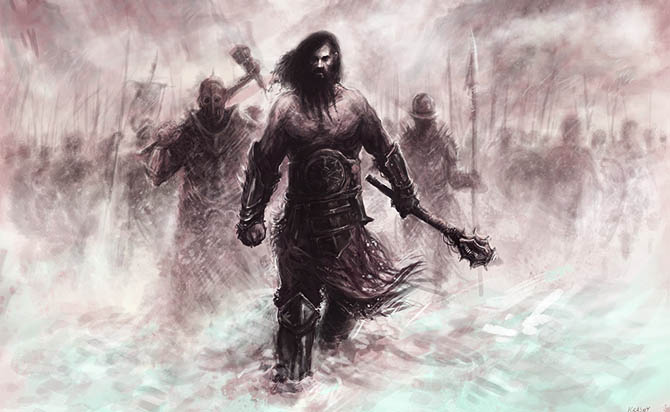
“Someone has rightly said that the type of a Chechen in his moral character has something resembling a wolf. The Lion and the Eagle show the strength, those go for the weak and the Wolf is on a stronger than himself, replacing the latter case, all – boundless audacity, courage and agility. And once he gets into trouble hopeless, he dies in silence, without expressing no fear, no pain, no groan “(V. Potto, XIX century.
“Wolf people”
As is known, the Chechen state emblem depicts a lone wolf under the moon, and the Chechen national anthem begins with the words: “We were born that night, when she-wolf whelped.” Even some Chechen journalists text of the anthem wrongly attributed to the late writer Abuzar Aydamirova, although it in his novel “The Long Night” notes that it is – the words of an old militant Chechen songs. The text of the battle songs can be found in many editions of the Chechen folklore and epics – both in the Chechen language, and translated into Russian. The song mentions “khahpa-Ely” ( “corrupt rulers”), as the object of military attack that allows to date the emergence of this song XVI -XVII centuries, when the Chechens have committed what are called “anti-feudal revolution” in the scientific literature, “establishment teip republic. “
“Wolf attributes” in the modern Chechen state symbols is far from accidental. It has a deep cultural and historical traditions. This, in particular, by the fact that the Chechen language, we find a strange word “berzloy”, which is usually in other languages translated as “wolves.” Indeed, the word “wolf” in Chechen sounds like “dogs” and “wolves”, respectively, “berzloy”. But one puzzle appears here. It consists in the fact that in nature there is no other animal, except the wolf, the name of which was added to the Chechens became the oldest suffix the word “loi”, literally meaning “people”. It is necessary to emphasize one more thing: the epithet “berzloy” Chechens represent, as a rule, people, men who have shown the highest valor.
“Loy” suffix itself is quite common in the Chechen language in the case when it is necessary to identify the profession or any other human trait. Here are some examples. “TIemloy” Chechen means “soldiers”, and the word literally means “people of the war” ( “tIom” – war, “Loy” – people). In Chechnya such taips how Bavloy – “people of towers” ( “bov” – “Tower”), TIerloy – “people from the top” ( “tIer” – “from the top”, “above”), ARCEL – “mountain people” ( “ARC” – “wooded mountain”), etc. Armenians call Ermloy Chechens – “people (the country) Arm” Tatars – “GIezloy” (probably the name is associated or with the Khazars, or to Kazan, there is no consensus on this matter). Such examples are numerous.
Riddle, about which we speak, is manifested in the fact that the word “people” ( “loi”) is present in the name of wildlife, wolves, and, without the word, which has become over time suffix, wolves name in the plural is not used. According to the norms of the Chechen language, the word “wolves” should be heard “berzash”, but it sounds just like a “wolf people”, “wolf people”. Why? The answer to this question reveals a very interesting historical and ethnographic parallels that lead into the depths of centuries. The fact that the clans of professional warriors, called “wolf people” there were very many peoples since ancient times. But in a living language in the actual application, the expression “wolf people” now preserved only the Chechens.
Wolf symbol in ancient cultures
Summarized how in ancient cultures was the perception of the image of the Wolf. The Hittite kingdom (II millennium BC.) Wolf played a special role, embodying the sacred quality. The wolf and the wolf pack were considered a model of solidarity, valor and wisdom. In addition, the Hittites believed that wolves prescient. So, the king Hattusili I (XVII century BC), referring to the meeting (pankusu), calls his soldiers “to be a single entity, as the wolf clan.” Soldiers wearing a wolf mask, stood out from the Hittites in a special category. We note that in the Hittite cuneiform script to refer to this category of soldiers used BAR.RA-as determinative and LU (LO), having a Sumerian origin. If we translate cuneiform icons in alphabetic schedule, this combination sounds very similar to the Chechen “berzloy”, especially since shumerogramma LU (LO) means, as in Chechnya, “the man.”
Oh man, showed great qualities stand out from the masses of people in some outstanding act, the Hittites said: “He became the Wolf.” In ancient India, in such cases, the person said: “He is the wolf.” Chechens in these formulas immediately hear her: “Iz kant tsha Borz u!” ( “This guy – a real wolf!”). It is worth adding that this flattering epithet for the Chechens in all cases associated with the manifestation of valor, though more often, of course, Wolf (Hounds) and Wolves (Berzloy) Chechens call people who have distinguished themselves in the military field. Note also that the naming of the Wolf, with the use of “women” and “the created” class indicator “w” ( “du”) – the only case in the Chechen tradition, when it is not perceived as an insult to the dignity of men. In all other cases, in relation to the man you need to use the class index of “wu”.
The famous Achilles – an exemplary soldier to the Greeks, according to Homer, had a “wolf’s heart,” that is perceived as a warrior-Wolf. In ancient Greece, a young warrior who killed the first enemy in battle, said: “He was the Wolf.” This corresponds exactly to the Germanic tradition, when a soldier, once in the first fight of his enemy, saying: “It will now be called the Wolf.” In general, the ancient Germans the most valiant warriors were called “people-wolves”, wore cloaks of wolf skins and they even practiced martial “Wolf dance” to pick up before the battle morale of the soldiers. In ancient Rome, Wolf was worshiped as a symbol of the deity of war Mars, it was believed that the appearance of a wolf before battle promises victory. Selected Roman soldiers of the Praetorian Guard, “the best of the best,” wore helmets hoods made of wolf heads, and often covered the back and shoulders Wolfskin.
Wolf as the personification of valor is found everywhere. The best warriors of the ancient Balts were called “servants of the Wolf.” The ancient Slavs worshiped Wolf so that his name was taboo and replaced by the word “Feb”, “bitter”. One of the Slavic tribes – lutici – were considered “children of the Wolf” and differed indomitable in battle. One of the most revered heroes of the ancient Slavs was a wolf ( “Volkhves”) Vseslavovich about which epic tells us that at his birth “to imitate the land of cheese and the blue sea skolybalosya”. In general, there were many peoples and tribes, whose name means “wolf” in the ancient world: these are the families of Lukani in Italy, the Balkans, Dhaka, Orcs in Phrygia, Urga – one of the Sarmatian tribes in the Caucasus, etc. But in order not to overload the work of historical details, yet dwell on these examples and continue to talk about the famous Viking Berserker.
Caucasian Viking roots
In the Scandinavian peoples (North Germanic), the personification of wisdom and perfect prototype of a warrior was considered a legendary king Odin (Woden) – the ancestor of the ancient royal dynasties of Europe, who came north with his sons and other satellites from somewhere in the south, to be exact – from the Caucasus. One of the chronicles tell of Caucasian origin Odin and all the Vikings (Norman) was a medieval German chronicler Saxo Annales. Many of these same traditions, allowing it to consider the Caucasus ancestral home of the Vikings are known, particularly in Iceland, where, thanks to the long-term isolation of the island, in the most complete form of preserved cultural heritage of the Vikings and their speech (Old Norse language).
American scholar Manly P. Hall, referring to the evidence, writes about the Caucasian origin of Odin: “It appears from the northern chronicles, Ziggy, leader of the tribe of Aser Asia, in the first century of the Christian era led the seed from the Caspian Sea to the north of Europe. He went from the Black Sea in Russia, where he left as the ruler of one of his sons; However, he did in Saxony and Frank. Then he moved to Denmark, which is recognized as the ruler of his fifth son Skold, and then to Sweden, where the Gilf, giving homage to the wonderful stranger, dedicated it to their Mysteries. Here Ziggy and regulations. The capital of the Empire, he did Zigtunu, gave a new code of laws, and founded the Sacred Mysteries. He himself took the name of Odin, founded the priestly clan of 12 Drottarov who conducted the secret services, administer justice, and as the prophets carried out the prediction of fate. “
It draws attention to the fact that, according to ancient German legend, King Odin’s identity is closely linked with the Wolf. For example, one of his trips are always accompanied by two wolves, and he often refers to a carnivorous animal. But the most interesting thing is that constant companions, Odin, his entourage are 12 soldiers, Berserkers, which are called «ulf-hedhinn». This word literally translated from the Norse meaning “warrior-wolf.”
We have already mentioned that many ancient peoples, including Chechens, selected warriors called Wolves, were “wolf” attributes (masks, hoods, coats of wolf skins), so it is not surprising that this tradition was inherent and warlike Vikings. Thus, it appears that this type of soldiers who made up the legendary times in Odin’s honor guard, and in historical time is the most efficient part of the Varangian warriors, are like two names: “berserk” and “voiny- Wolves» ( «ulf-hedhinn» ).
With the interpretation of the name «ulf-hedhinn» there is no problem, because it has a clear explanation to the Old Norse language and means “wolf-warrior”, and in a literal translation – “a warrior, wearing the skin of a wolf.” With regard to the origin of the word “berserker”, it is still uncertain and causes great controversy among historians and linguists, German studies.
Note that in fact the original, primary sound of a word pronounced as «borsork» (umlaut), which roughly corresponds to Russian writing “bёrsёrk”. So, some linguists believe that the word means “bear shirt”, while others prefer to translate it as “barons warriors”, others interpret it as “voiny- bears.” But here there are difficulties. The fact that none of the historical sources do not mention that the berserkers ever in the battle wore the skin of a bear. On the contrary, they are always and consistently engage in in wolf skins, and their very name «ulf-hedhinn», as mentioned above, means literally “a warrior, wearing a wolf’s pelt.”
As for the other treatments ( “voiny- barons”), then it is rejected by most scientists Germanists as barons among the Vikings never had – the feudal title appeared for the first time the Franks. In Western Europe, it was worn large zemlevladeltsy- nobles, lords, Lady, is the direct vassals of the king. Indeed, it is difficult to imagine that the berserkers, who do not know anything in life, except for military craft, and do not possess almost any property, other than weapons, might have something in common with the rich feudal lords – the owners of castles, lands and serfs.
“Berserkers” – a “berzloy”?
In the analysis of the word “berserker”, the most common such its breakdown: Bears-Erk (bors-ork). Given the “Caucasian” origin such as Odin and Viking at all, and even without this origin, attracts the attention of a similar sound of the word with the Chechen word “berzloy”, which we discussed earlier in this article. “Berz-loi” ( “wolf people”) and “Bears-Erk” ( “wolf warriors”) – as we have seen, the initial components of the word for “wolf”, in both cases, the sound almost identical ( “c” and “z” are known and are hollow ringing embodiments of the same sound).
Every one moved to Scandinavia from the Caucasus and once Berserkers are a permanent military entourage, retinue Odin, we can safely assume that this term, embarrassing its mystery Germanists scientists came to the northern Germans from the Caucasus. In other words, one went to the north of the Caucasus, accompanied by selected warriors, “berzloy-warriors” because sluggish and indecisive people would hardly have been tempted so long campaign with its dangers and dim prospects.
If the identity between the components of the “Bears” and “Berz” seems to us obvious, it is more difficult to find an identity between the components of “Erk» (ork) and “loi”. But the complexity of this rather successfully overcome, if we remember that in the old Germanic languages the word and its different variations designated army soldiers, and in a more general sense – “armed people” (as it is known, in ancient societies, only the warriors were considered full citizens). In general, the derivational base «er», «(h) er», «ger» underlies most Indo-European designations “force”, “soldiers”, “characters”, etc.
But not only in Indo-European. So, in the Sumerian word “eri” called “army”, “armed people”, Georgians «(h) eri» – «squad”, “army”, the Chechens “gIayr” – “Wasps squad”, “squad”. These examples can be continued for a long time, but the result of them will conclude that the term “Bears-ERC” is accurate semantic calque «ulf-hedhinn» and means as well as Chechen “Berz-loi”, literally “wolf warriors”, ” wolf warriors. “
The well-known traditionalist Mircea Eliade, referring to the Scandinavian “Saga of Völsunga” tells the story of Berserk Sigmund and his son Sinfotli, donned wolf skins and powerless to part with them until they commit military exploits, said: “The transformation into a wolf – that is, the ritual of donning wolf skins – it was the most important moment of initiation into a secret society of men. Putting on the skin, initiated by the wolf took over the behavior; in other words, he became a warrior beast irresistible and invulnerable. “Wolves” were called members of the Indo-European military societies “





Leave a Reply